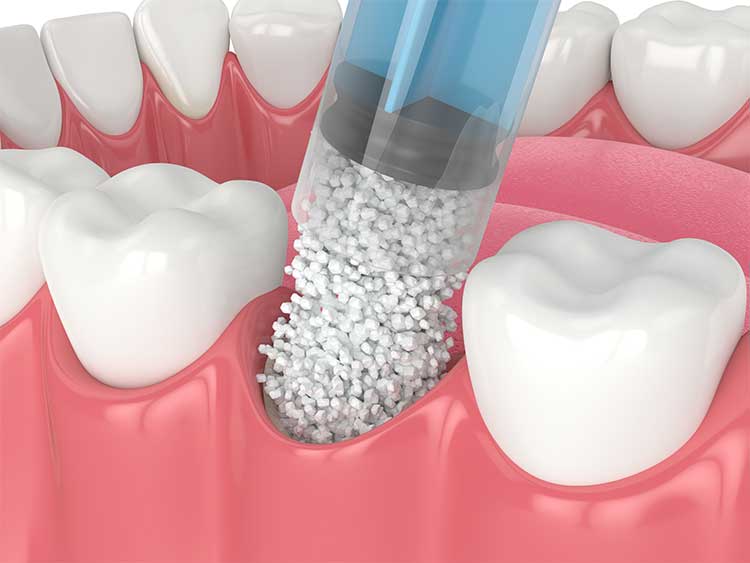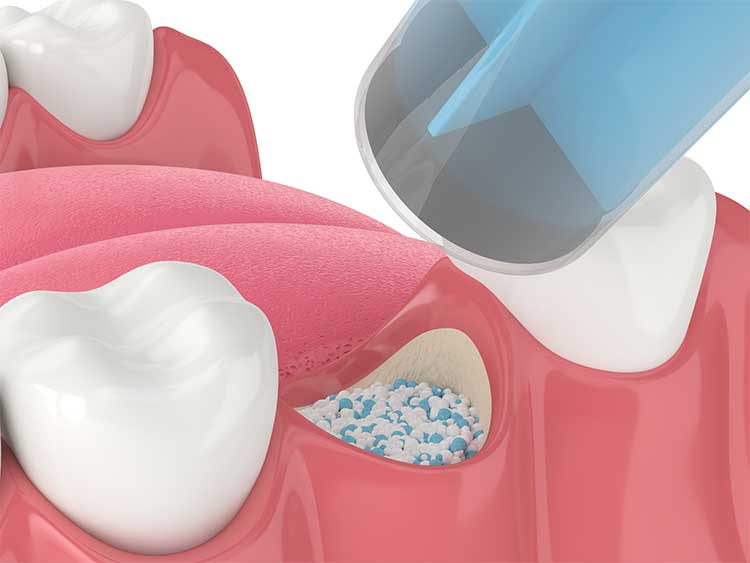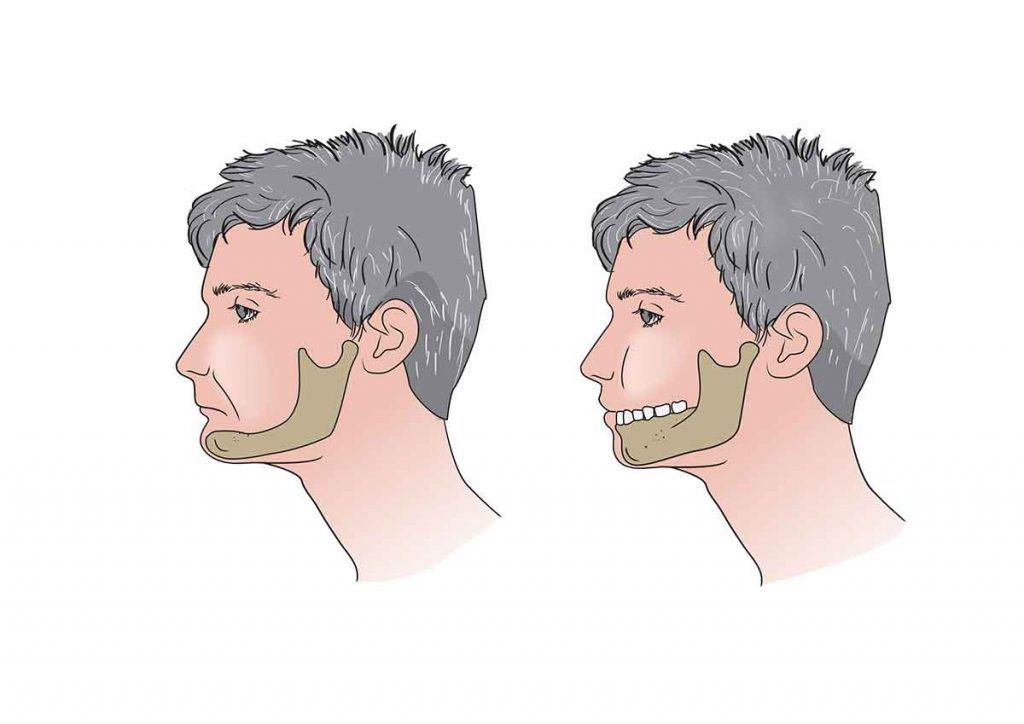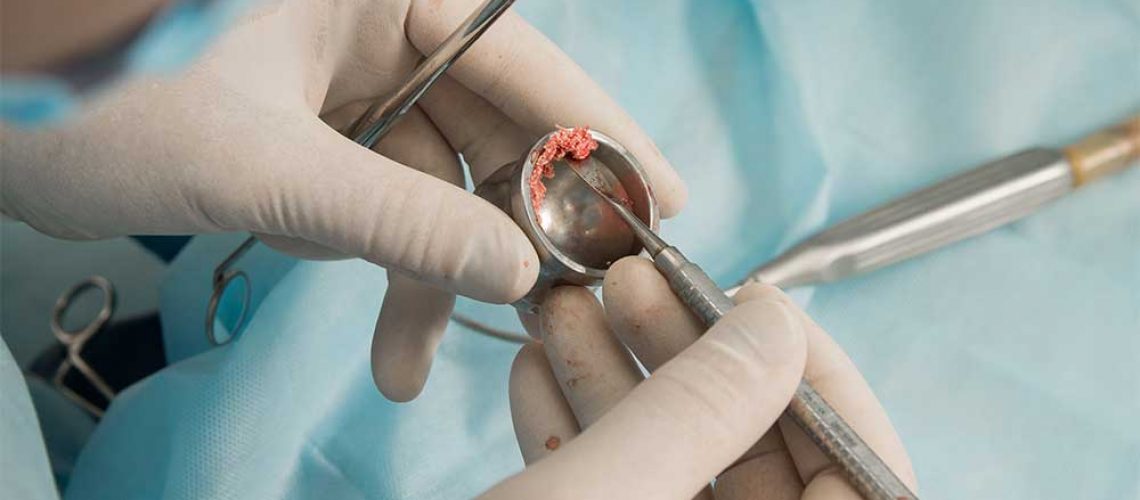Dental implants are special tooth replacements that are surgically placed and in the jawbone. As such, you need enough healthy bone structure to support them properly. One question our patients ask is whether they need bone grafts before their implant(s) can be installed. Bone grafting before dental implant surgery strengthens the bone under your gum tissue for successful dental implant placement. If you’re someone who has missing teeth, suffered from periodontal disease in the past, or your oral surgeon is planning a tooth extraction, the bone at that surgical site may already be fairly weak. Fortunately, ridge augmentation can make implant surgery possible, even when you might not have otherwise qualified for a replacement tooth.
What Is A Dental Bone Graft?
Dental bone grafts are a surgical procedure that adds volume to your jawbone using natural or synthetic materials. Once natural bones start integrating with your jaw, they add density, width, and height to your planned implant site. As your body accepts the bone graft material, your natural bone tissue health improves at that site. This process isn’t just important for placing an artificial tooth root but is also essential when trying to preserve adjacent natural teeth after a tooth extraction. There are different forms of bone graft material frequently used. The best bone grafting material for your specific dental implant surgery will be selected by your dentist or oral surgeon.


How Do Bone Grafts Work?
In a nutshell, bone grafting adds reinforcement to your jawbone. When performing a dental bone graft, the transplanted or synthetic material is placed directly next to your alveolar bone, which is what supports your tooth roots (or, in this case, dental implants.) The bone grafting procedure is not immediate. Every bone graft requires some time to integrate with your body, whether placed in the upper jaw next to your sinuses or in the lower jaw. It may take a few months or so before the dental bone graft is ready to perform the dental implants procedure. As your healthy bone tissue integrates with the graft, replacing missing bone, you’re essentially reversing loss of alveolar bone so that an artificial tooth can be installed next to your natural teeth.
When your implant dentist replaces missing bone, it improves your success rate and recovery after dental surgery. Even with lost bone density, synthetic bone grafts or transplanted bone can take a person who otherwise doesn’t qualify for dental implants and give them a successful dental implant surgery.
Who Needs Bone Grafting?
Here are some of the most common scenarios where bone grafting is required:
During a Sinus Lift: Dental implants take up as much space as a natural tooth root. So, if you had an upper tooth extracted just below your nasal sinuses, you will need to make sure that the sinus lining is still lifted high enough for implant installation. A sinus lift with bone grafting material will create enough safe space for the implant to set inside of your jaw. Dental bone grafts are almost always required for this specific type of oral and maxillofacial surgery.
During or After a Tooth Extraction: An extracted or lost tooth leaves an open void inside the jaw. This can cause the surrounding bone to resorb (shrink), which then reshapes your soft tissues. A socket graft or socket preservation is where we recreate bone inside of the void after your dental specialist removes the tooth.
Recovery from Periodontal Disease: Even if you’re not planning on getting a dental implant, you might need a bone graft if your gum tissue was previously infected with periodontitis. Since gum infections destroy the bone making up your alveolar ridge, a graft will promote a stable foundation for your smile.
To Support Neighboring Teeth: Transplanting healthy bone tissue during your bone augmentation procedure helps to reinforce the support of teeth next to that area. Since bone loss usually tends to progress with time, a dental bone graft will stop or delay that bone loss to help you avoid another missing tooth in the future.
If You Don’t Qualify for Dental Implants (because of bone loss): In years past, it was common to inform prospective dental implant patients that they didn’t qualify for dental implants. Why? Because there was not enough bone to support them. But a bone grafting procedure can change that. Working with an experienced implant dentist and having this minimally-invasive maxillofacial surgery prior to dental implant installation can open up the doors of opportunity to more people than ever before.
Why Does Tooth Loss Cause Bone Loss?
Alveolar bones support your teeth and hold them on. With no tooth in that space, the blood vessels and bone immediately in that area will shrink back. Some stimulation from biting and chewing is essential to prevent your otherwise supporting tissues from deteriorating. We often see changes in human bone and gum tissues, even in people who wear full removable dentures (which can cause premature aging in their face.)
If you want to replace missing teeth with dental implants, you need accurate foundations (from a dental bone graft) to install them. If no bone exists, it’s impossible to place an implant. Every dental implant needs just as much bone to support it as you would for a natural tooth. This is why bone grafting is so essential after tooth loss!

How Do You Prepare For A Bone Graft?
Your bone graft surgery can be quite simple or complex, depending on your needs (and the type of dental bone grafts used.) To ensure your comfort, your dentist will use pain management techniques like local anesthetic, sedation, or even general anesthesia (if your dental bone graft is being performed during a more complex surgical procedure.) Always follow your home care instructions accurately. And with sedation, be sure to bring a friend to drive you home.
We Can Help You With Bones Graft for Dental Implants
Are you planning to get a dental implant? Have you been told that dental implants aren’t an option because you need a dental bone graft? Dental implants rely on healthy, new bone to keep them in place.
To learn more about bone grafting in Leawood and Kansas City, call Gordon Dental today!

